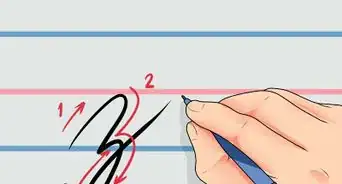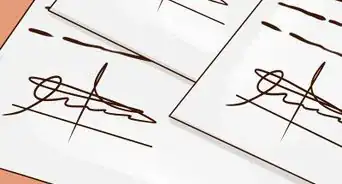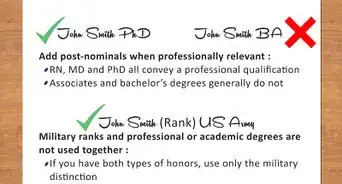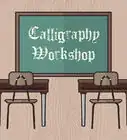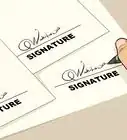This article was co-authored by wikiHow Staff. Our trained team of editors and researchers validate articles for accuracy and comprehensiveness. wikiHow's Content Management Team carefully monitors the work from our editorial staff to ensure that each article is backed by trusted research and meets our high quality standards.
wikiHow marks an article as reader-approved once it receives enough positive feedback. In this case, 85% of readers who voted found the article helpful, earning it our reader-approved status.
This article has been viewed 123,251 times.
Learn more...
Whether you want to create detailed calligraphy or beautifully embossed letters, learning to write elegantly is a skill that requires time and determination. There are practical steps you can take to make your writing fancier. However, in order to develop your skills fully, you must find the right materials, strike the correct pose, and practice your writing daily. Before you know it, you will find yourself writing with an elegant flare.
Steps
Trying Fancy Fonts and Letter Styles
-
1Trace an elegant font. Find a font on Microsoft Word or another word processing program, print out the letters, and begin tracing them. Practice tracing these letters on a blank piece of paper.[1]
- First trace the letters on a lined sheet of paper and then move to a blank sheet.
- Some pens work better than others. Try gel ink pens and calligraphy pens, however, if you cannot find those then a pencil will work just fine but will not have quite the same.
- A light box will be very useful for tracing the letters.[2]
-
2Write in loopy cursive. Instead of printing, try writing your daily notes, homework and other handwriting in a distinctive cursive style. Emphasize the loops in letters and try not to jumble words together. Take your time and really concentrate on making your cursive look pretty.Advertisement
-
3Copy sections from your favorite book. It might help your writing if you practice copying something that you enjoy reading. In your elegant cursive, write what you are reading into your journal or notebook. Take your time and emphasize your style. [3]
- You can also use line paper if you are still trying to master your style.
-
4Practice writing letters of different widths. Elegant handwriting can be thicker or thinner depending on the type of writing utensil used. Markers are going to give you a larger font, while pens and pencils will be skinnier. Try out different writing tools and find one that works for you.
- Your art teacher or an employee at an art supply store should be able to recommend different writing tools for you to use.
-
5Emphasize elongated letters. Buy a lined paper that has an extra-large space for writing. Think of the kind of paper that you learned to write on when you were little. Slowly write your elegant letters, being sure to fill up the entire space. With practice, you will eventually be able to do this without the lines.
- Take your time and really concentrate on filling the space.
-
6Learn calligraphy, which is the art of creating decorative handwriting. By practicing this visual art, you will learn how to write multiple styles of elegant handwriting. Calligraphy teaches you how to write elegantly with different tools in different medium. You will also develop the skills produce your own unique styles and fonts. If you stick with it, you will eventually be able to print, paint or chisel beautiful words on almost anything. [4]
- There are workbooks and classes that you can take online to learn calligraphy.
- Your local community center or YMCA may also offer classes in calligraphy.
Practicing Consistently
-
1Write with your shoulder and back. The muscles in the arm, shoulder, chest and back should be conducting all of the action while you write. Your forearm, hand and fingers should be still. Writing from your shoulder results in movement that is more intricate and gives you greater stamina. It also creates smoother and cleaner looking writing.
- This movement will likely feel unnatural at first but it is crucial to developing your writing.
- Avoid writing with your fingers. The majority of people “draw” their letters by moving the pen across the paper with their hand. This method is more tiresome and gives you less control over your writing.
- Be conscious of writing with your shoulder, making it a part of your writing practice.
-
2Hold your arm out in front of you and practice writing big letters in the air. Concentrate on writing using your shoulder and not your hand. Practice this until it feels natural. As you become more comfortable with the movement, make the letters smaller.
- You can also practice this method on a marker or chalk board.
-
3Practice your movements with a pen in your notebook. Start with big letters and gradually move to smaller ones. Again, remember to avoid writing with your fingers and concentrate on your shoulder.
-
4Practice strokes and figures. Start making Xs and ///s and OOOs and overlapped OOOs and spirals and | | | |s. Work on making this figures smoothly, uniformly, and evenly spaced. Practice drawing these figures daily emphasizing your strokes and movement.
- Repetition is important so practice these movements daily.
-
5Slow down and write methodically. Focus on making clear, well-formed letters and words. Hurriedly writing results in messy or illegible writing. Remember that you want to write elegantly and that takes time.[5]
-
6Remember to stretch and move around. If you begin to get sore or fatigued, your writing will suffer. Get out of your chair and walk around. Stretch the muscles in your shoulder and hand. [6]
-
7Practice your handwriting every day. There is not magic bullet for developing elegant handwriting. Daily practice is the only way to hone your skill and, luckily, there are many strategies for doing this.[7]
- Set aside at least 20 minutes a day to write. Begin with five minutes and work your way up.
- Follow the curriculum laid out in a handbook or online lesson. These tend to have daily exercises as part of their instruction.
- Write things out by hand more. Hand-write your notes and grocery lists. Start a journal and send written letters to friends and family. Keep a pocketbook.
Improving Your Posture and Grip
-
1Place the pen over or just forward of the knuckle on your index finger. Hold it near the writing end. It is important to have the proper grip on your writing utensil. Think of your hand as the vice that holds the pen in place while you write.
- Try not to rest it between the thumb and index finger with the barrel on the middle finger.
- Avoid placing the pen between thumb and the index and middle fingers with the pen resting on you ring finger.
-
2Hold the pen lightly. Relax your hand while you hold the pen. Your grip needs to be firm but not so tight that your hand is tense. Having a loose grip helps relax your arm and give it greater dexterity.
- Imagine that the pen is made of soft rubber and that squeezing it too tightly will cause ink to blot everywhere.
-
3Keep your fingers straight and write slightly above and between your thumb and index finger. Do not curl your hand over and write to the left of your palm. That position can leading to hand cramping and discomfort.
- This is an important tip for lefties to remember since they are more likely to curl their hand.
-
4Use your non-writing hand to hold the paper and balance you while you write. This will help you steady yourself and provide better control to your dominant hand. It will also keep the paper from moving around. Be sure you are practicing on a surface that has space to balance yourself with your other arm.
- Think about your dominant hand and position yourself in a way that gives you room to both balance and write.
-
5Properly position the paper on the writing surface. The paper position ensures the correct slant of your letters. Your letters should ideally have a 35-degree slant.[8]
- If you are right-handed, the bottom-left corner of the paper should be aligned with the top-right.
- If you are left-handed, the top-left corner should be aligned with the bottom-right corner.
-
6Sit up straight and avoid slouching, but not stiffly. Keep your spine straight and be sure to have enough space to move your shoulder freely. Try to stay loose and not be too tense while writing. Find a comfortable hard-backed chair to sit on.[9]
- Avoid sitting on a couch or a recliner.
Choosing the Best Materials
-
1Find the pen or pencil that works for you. It needs to feel comfortable to hold and move across the paper smoothly without requiring you to push it too hard on the paper. Depending on how elegant you want your handwriting to look, you may want to invest in different writing utensils.[10]
- Fountain pens are believed to be the superior tool for handwriting. The expenses associated with a fountain pen are slightly higher due to the need to buy ink.
- Mechanical pens and pencils are also great choice. They allow you to try out different sized nibs and thicknesses, as well as colors.
- If you are left-handed, there are special pens designed just for you.
- For those looking for a more rustic look, a quill might be worth looking into.
-
2Get a notebook. For practicing, you will want grid-lined paper because it will help you write lower and upper case letters, as well as track your progress. [11]
- There are colored and raised papers for the visual perceptual challenged.
-
3Find a large flat surface for writing on. If you have access to it, a drawing or drafting table is ideal for handwriting. Experts recommend writing at a 45-degree angle; however, a kitchen table or office desk will also work.
- Depending on the type of handwriting you are doing you might want to invest in a light box, which will help you write on paper without a grid.[12]
-
4Buy a handwriting course book. These workbooks have daily exercises to help you refine your writing. Depending on your skill level, there are also advanced books teach specific styles and scripts. [13]
- You can take handwriting courses online and some tablets have tools that will help you practice your writing.
Community Q&A
-
QuestionCan I use song lyrics instead of a book?
 Skylar WilsonCommunity AnswerYes, you definitely can. You can use the lyrics to your favorite song, or do a short song like "Happy Birthday".
Skylar WilsonCommunity AnswerYes, you definitely can. You can use the lyrics to your favorite song, or do a short song like "Happy Birthday".
References
- ↑ http://julieblanner.com/calligraphy-alphabet/
- ↑ http://www.businessinsider.com.au/tips-to-improve-handwriting-2014-7
- ↑ http://www.businessinsider.com.au/tips-to-improve-handwriting-2014-7
- ↑ http://www.reed.edu/calligraphy/
- ↑ http://www.artofmanliness.com/2014/12/16/improve-your-cursive-handwriting/
- ↑ http://www.businessinsider.com.au/tips-to-improve-handwriting-2014-7
- ↑ http://www.artofmanliness.com/2014/12/16/improve-your-cursive-handwriting/
- ↑ http://www.artofmanliness.com/2014/12/16/improve-your-cursive-handwriting/
- ↑ http://www.businessinsider.com.au/tips-to-improve-handwriting-2014-7
About This Article
To have elegant handwriting, make sure you’re holding your pen or pencil lightly near the writing end and over or just forward of the knuckle on your index finger. Write slowly at first and focus on making clear, well-formed letters over and over again. Next, try to set aside at least 20 minutes a day to practice and write out as many things as you can by hand, like grocery lists and personal notes. For tips on how to improve your hand’s movement across the paper as you write, keep reading!





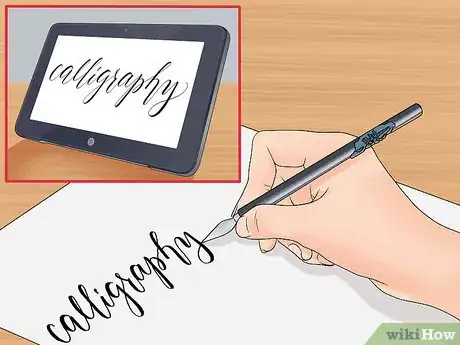


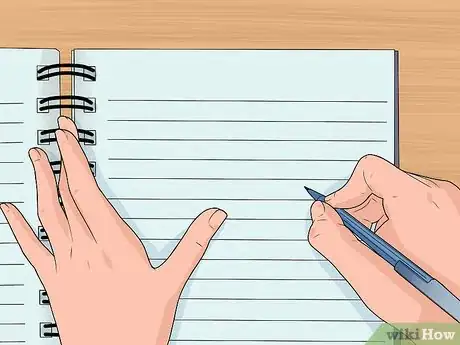






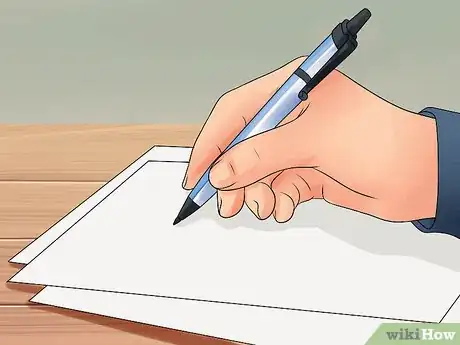
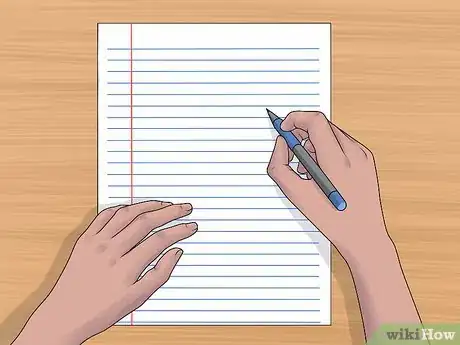
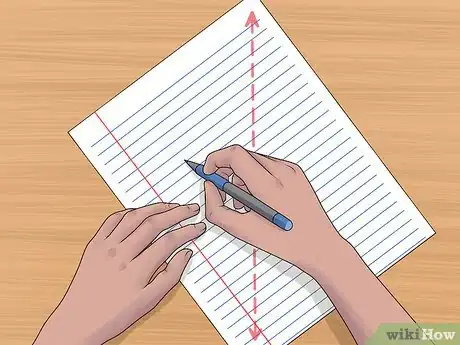

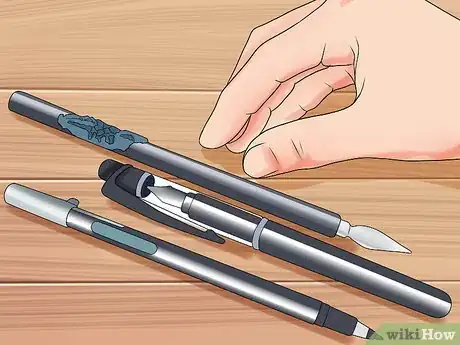
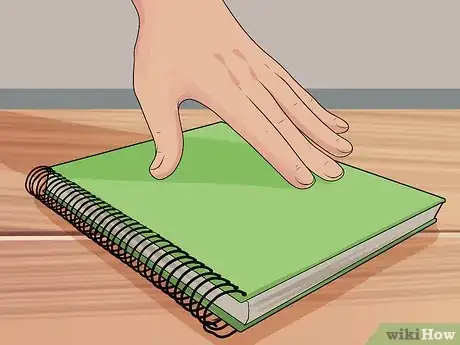




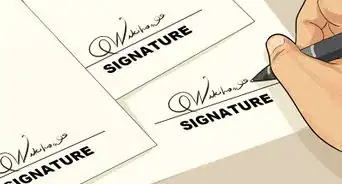
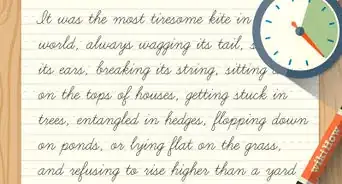
-Step-11-Version-3.webp)




